 |
| June 20, 2017 | Volume 13 Issue 23 |
Designfax weekly eMagazine
Archives
Partners
Manufacturing Center
Product Spotlight
Modern Applications News
Metalworking Ideas For
Today's Job Shops
Tooling and Production
Strategies for large
metalworking plants
Gun metal: Army cold spray process reclaims unrepairable metal parts
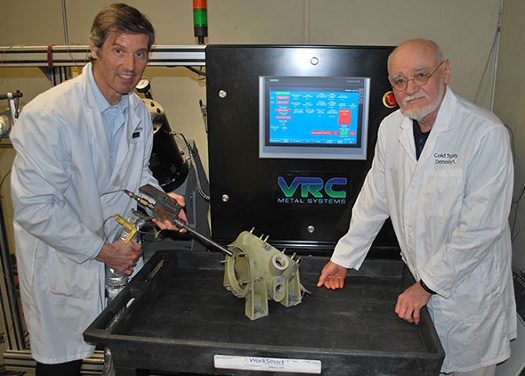
ARL's Victor Champagne and Dr. Dennis Helfritch, both with the Weapons and Materials Research Directorate, invented the "Cold Spray Device and System," which shoots metal particles at high velocities to repair parts. [U.S. Army photo by Joyce M. Conant]
The U.S. Army Research Laboratory and the South Dakota School of Mines (SDSM), through a joint ownership agreement, commercialized a system to reclaim unserviceable parts and reduce the amount of maintenance required by military and commercial sectors. VRC Metal Systems, a start-up company from SDSM, manufactures the cold spray system. The National Council of Entrepreneurial Technology Transfer recognized the company as one of the 40 best university startups for 2017.
ARL's Victor Champagne and Dr. Dennis Helfritch, both with the Weapons and Materials Research Directorate, invented the "Cold Spray Device and System," which is a novel approach to forming coatings or near net shaped parts through the supersonic acceleration and subsequent impact and consolidation of particles in a stream of gas (either air, nitrogen, or helium) incorporating a small device that can be used by hand in a variety of operating environments.
"The system can be manipulated manually and has a compact design allowing it to be used in remote areas of operation such as in an aircraft hangar, on an oil rig in the ocean, out in the middle of a dessert, or other remote areas apart from the factory floor. This has allowed in-situ repair of corroded and worn metal parts such as expensive aircraft parts, components on vehicles, munitions, ships, submarines, and other applications," Champagne said.
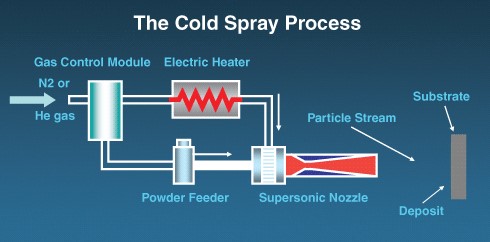
The cold-spray process.
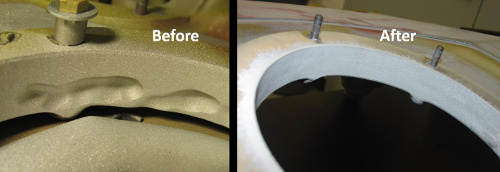
Part before and after cold-spray application.
According to a Government Accounting Office report, the DOD spends between $10 billion to $20 billion annually on corrosion prevention and mitigation. Champagne and Helfritch's system has been used to improve corrosion resistance and reduce the amount of maintenance required by military and contract personnel for the DOD and commercial sectors. A recent study commissioned by the National Association of Corrosion Engineers suggests the national corrosion bill has an annual value exceeding $270 billion.
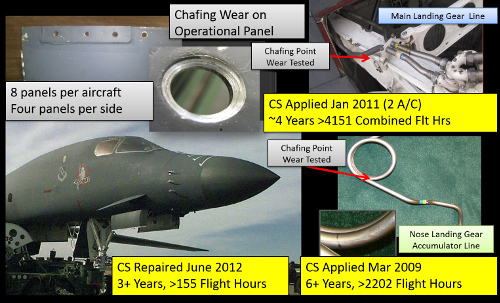
Cold-spray application examples used in the military.
Champagne developed the use of cold spray for repairing corroded and worn parts, which has significantly reduced the costs associated with the corrosion and damage caused during service of parts used in Army, Navy rotorcraft, and Air Force fixed-wing as well as all commercial aircraft.
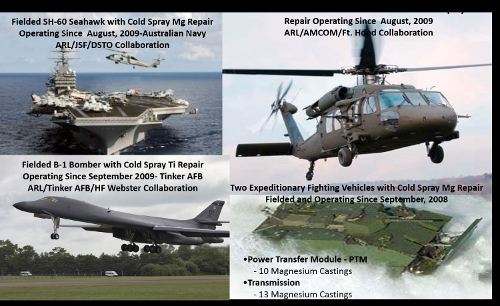
More cold-spray application examples used in the military.
According to Champagne, the system has saved the DOD more than $100 million annually in sustainment costs, and commercial savings are equal or even higher.
"Applications using this system have also been developed to contain nuclear waste in various proprietary applications for the Department of Energy. It has been recognized as an additive manufacturing technique that is able to produce exotic materials that cannot be achieved by conventional ingot metallurgy or by other competing AM techniques such as laser sintering or electron beam techniques, because cold spray is a solid-state consolidation method and does not melt the starting feed stock materials (which is metal powder), enabling it to produce novel materials and near net shaped parts for production or field applications," said Champagne.
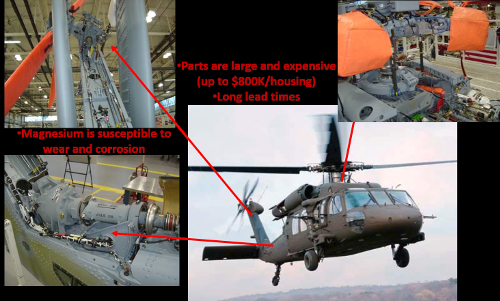
Some benefits of cold-spray applications.
He said the difference between this system and conventional cold spray is that it is truly portable, and it has been designed for manual operation or can be used on a robot, making it a "hybrid" system.
"The novel design utilizes a single powder and gas stream and has more capability than any other system, having the capacity to spray at 900 degrees C and at 1,000 psi. The gun weighs only a couple of pounds while the system only takes up a small space, allowing it to be taken into remote areas and tight locations," said Champagne. "No other system in the world can match the versatility and flexibility, allowing it to spray into confined areas and over complex geometries."
The Cold Spray System has revolutionized field repair of components and has had a profound effect on reducing sustainment costs in several important industry sectors, including not only aerospace but automotive, petrochemical, electronics, and the medical industry.
Champagne said commercial companies benefiting from this technology include Sikorsky, Boeing, Bell Helicopter, Pratt and Whitney, General Electric, Rolls Royce, Honeywell, Lockheed Martin, Westinghouse, and United Technology, among others.
He added that commercial uses include aircraft, automobiles, race cars, nuclear power plants, oil rigs, ships, electronic circuit boards, power modules, hospitals (antimicrobial coatings for medical equipment), aircraft carriers, and submarines.
Sources: U.S. Army Research Laboratory, VRC Metal Systems
Published June 2017
Rate this article
View our terms of use and privacy policy
